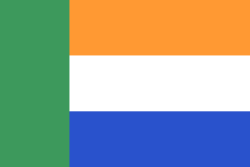Afrikaner Volksfront
This article needs additional citations for verification. (October 2015) |

The Afrikaner Volksfront or AVF (Afrikaner People's Front) was a separatist umbrella organization uniting a number of right-wing Afrikaner organizations in South Africa in the early 1990s.
History
The AVF was formed by General Constand Viljoen and three other generals from the South African Defence Forces and launched on 7 May 1993.[2] The AVF President was Dr Ferdi Hartzenberg, leader of the Conservative Party, and the chief secretary was Colonel Piet Botha.
The AVF existed as an umbrella group for right wing groups rather than a party in itself. Other groups involved included the Boerestaat Party, the Herstigte Nasionale Party and the Oranjewerkers [1]. The AVF aimed to disrupt the 1994 elections.
The AVF established a Volksrepubliek werkkomitee (People's Republic working committee) to gather information and put the ideal of Afrikaner self-determination into practice. In September 1993 this committee recommended a Volkstaat solution incorporating Pretoria, parts of the Transvaal, and northern Kimberley and Northern Natal, which would exist as a state with the right to secede from a federal South Africa; in November 1994 a new proposal was suggested for a smaller state with just autonomy.[3] The negotiations held with the ANC displeased hardliners within the AVF, with Hartzenberg demanding nothing less than an independent Afrikaner homeland.[4] After negotiations failed Viljoen's position in the AVF was undermined by the hardliners; Viljoen left and subsequently formed the Freedom Front.[5] The AVF rejected the interim constitution of South Africa which was passed in November 1993.[6]
In 1994 the AVF sought to have the Boers recognized as an indigenous people by the United Nations but were unsuccessful after 82 other indigenous peoples signed a petition against the AVF's participation.[7]
The AVF was disbanded in November 1996.
References
- ^ South African Bureau of Heraldry (1995) Afrikaner-Volksfront flag, retrieved 28 June 2006
- ^ van Rooyen,Johnann Hard Right: The New White Power in South Africa I.B. Tauris (1994) p113
- ^ van Rooyen,Johnann Hard Right: The New White Power in South Africa I.B. Tauris (1994) pp114-115
- ^ van Rooyen,Johnann Hard Right: The New White Power in South Africa I.B. Tauris (1994) p115
- ^ Seddon, David with Seddon-Daines, Daniel entry on Viljoen in a A political and economic dictionary of Africa Routledge (2005) p556
- ^ Noel, Sid (editor) From Power Sharing to Democracy: Post-Conflict Institutions in Ethnically Divided Societies McGill-Queen's University Press (2005) p151
- ^ Morgan, Bronwen (editor) The Intersection of Rights and Regulation: New Directions in Sociolegal Scholarship Ashgate Publishing (2007) p125
External links
- 1993 establishments in South Africa
- 1996 disestablishments in South Africa
- Afrikaner nationalism
- Boer nationalism
- Defunct political parties in South Africa
- Far-right politics in South Africa
- Organisations associated with apartheid
- Political parties disestablished in 1996
- Political parties established in 1993
- Political party alliances in South Africa
- White nationalism in South Africa

